Polyvagal theory shows how your vagus nerve influences your emotional regulation and social connection. When it’s active, you feel calm, safe, and ready to connect, while reduced activity can lead to anxiety or shutdown. Your nervous system shifts between states of safety, danger, and helplessness based on cues your body interprets. Engaging strategies like mindful breathing and gentle gestures can boost vagal tone. To discover how these processes work together, keep exploring these fascinating connections.
Key Takeaways
- The vagus nerve connects the brain to vital organs, supporting emotional regulation and social engagement.
- Activation of the vagus nerve promotes calmness, trust, and safety signals essential for emotional resilience.
- Polyvagal Theory describes how the nervous system shifts between states: social engagement, fight/flight, and shutdown.
- Enhancing vagal tone through practices like deep breathing fosters emotional stability and reduces stress responses.
- Understanding vagal pathways informs interventions to improve mental health, social connection, and adaptive stress management.
Understanding the Vagus Nerve and Its Functions
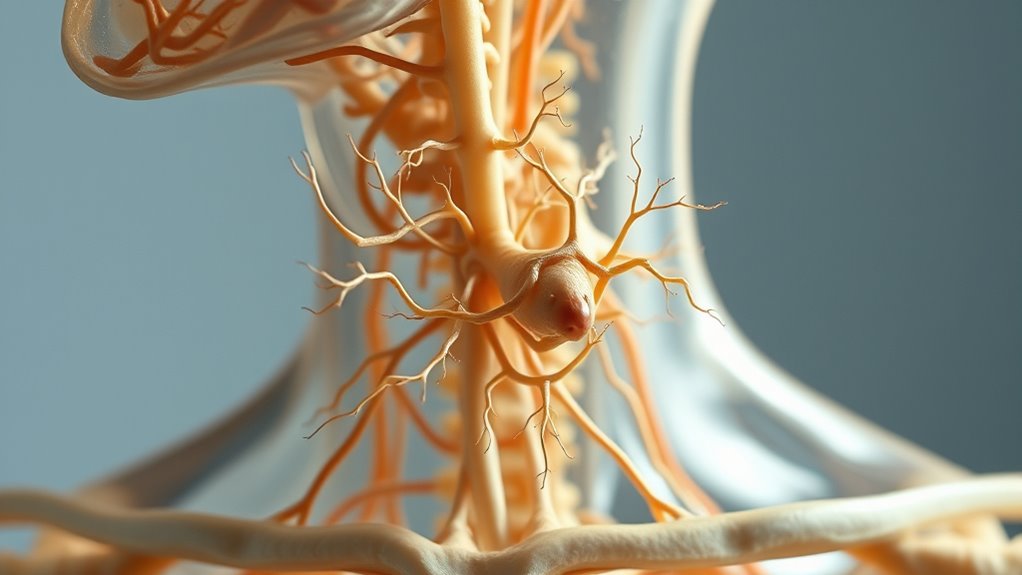
The vagus nerve is a fundamental part of your body’s nervous system, acting as a communication highway between your brain and many essential organs. Its vagal pathways enable signals to travel efficiently, supporting critical functions like heart rate, digestion, and breathing. This nerve plays a key role in autonomic regulation, balancing your body’s responses to stress and relaxation. When the vagus nerve is active, it promotes calmness and restoration, helping you recover from stress. Conversely, reduced vagal activity can lead to heightened anxiety or difficulty calming down. Understanding these functions highlights how the vagus nerve influences your emotional state. By supporting its health, you can enhance your ability to regulate emotions and maintain overall well-being through proper autonomic regulation.
The Origins of Polyvagal Theory
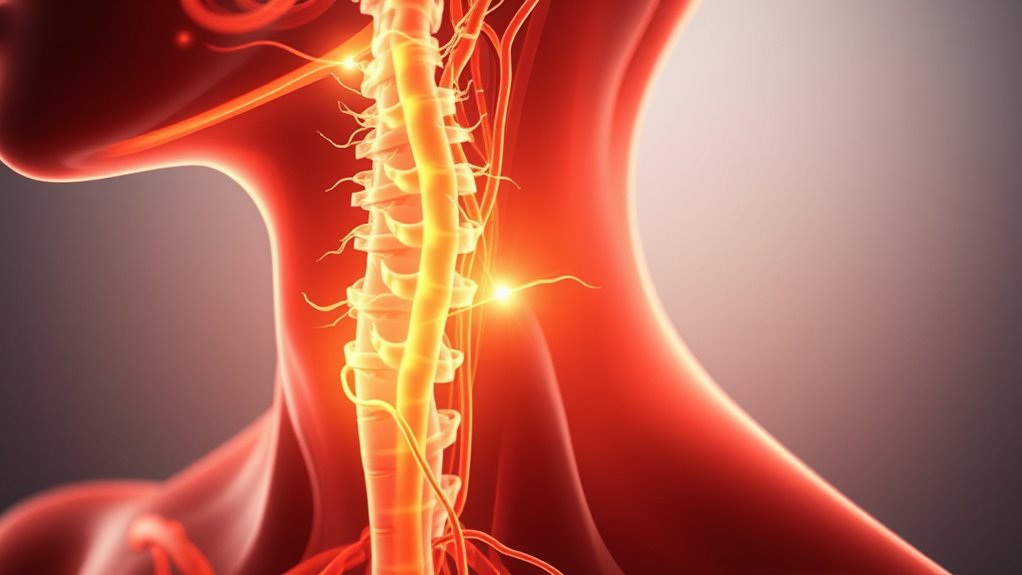
Polyvagal theory originated from the groundbreaking work of neuroscientist Stephen Porges, who sought to understand how our nervous system influences social behavior and emotional regulation. From an evolutionary perspective, Porges examined the historical development of the autonomic nervous system, focusing on how different neural pathways evolved to support survival and social engagement. His research challenged traditional views by highlighting the importance of the vagus nerve’s unique role in these processes. Porges observed that mammals developed a more complex vagus system to adapt to social environments, promoting calm states and connection. This evolutionary perspective laid the foundation for the development of polyvagal theory, providing new insights into how our nervous system’s structure influences our emotional and social behaviors. Additionally, his findings emphasize the significance of the vagus nerve’s autonomic nervous system in regulating our physiological responses to stress and social cues, with recent studies demonstrating how emotional regulation is closely linked to vagal activity. Understanding the neural pathways involved offers a comprehensive view of how our body and mind work together to foster social connection and resilience.
The Three States of the Nervous System
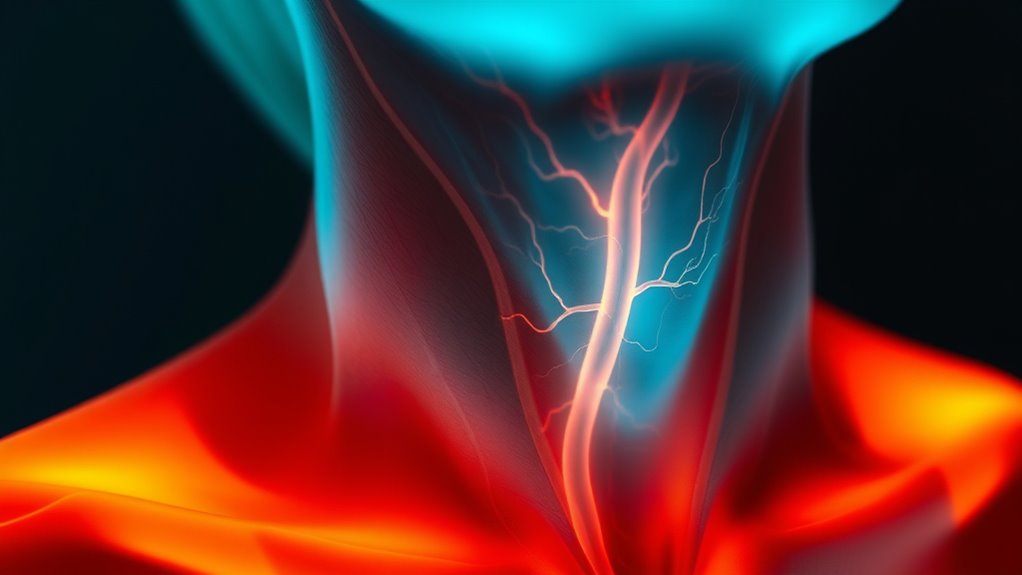
Have you ever wondered how your nervous system shifts between different emotional states? Your autonomic nervous system operates in three distinct states that influence your feelings and reactions. These are:
- Ventral Vagal State – a state of calm, social engagement, and emotional resilience, where you feel connected and safe.
- Sympathetic State – the fight-or-flight response, energizing you to respond to danger but reducing emotional resilience.
- Dorsal Vagal State – a shutdown or freeze response, leading to feelings of numbness or dissociation, disrupting autonomic balance.
- Transitioning – moving between these states, which is essential for emotional regulation. Understanding these states helps you manage stress and maintain a healthy balance in your nervous system. Signs of a healthy transition include noticing changes in your physical sensations and emotional feelings, much like how fresh lemon juice can be distinguished from spoiled based on smell or taste signs of spoilage. Recognizing these shifts can help you engage in mindfulness practices that promote better regulation and resilience within your nervous system. Additionally, awareness of how trauma or chronic stress can affect these states can support emotional healing and stability.
How the Vagus Nerve Influences Emotions and Behavior
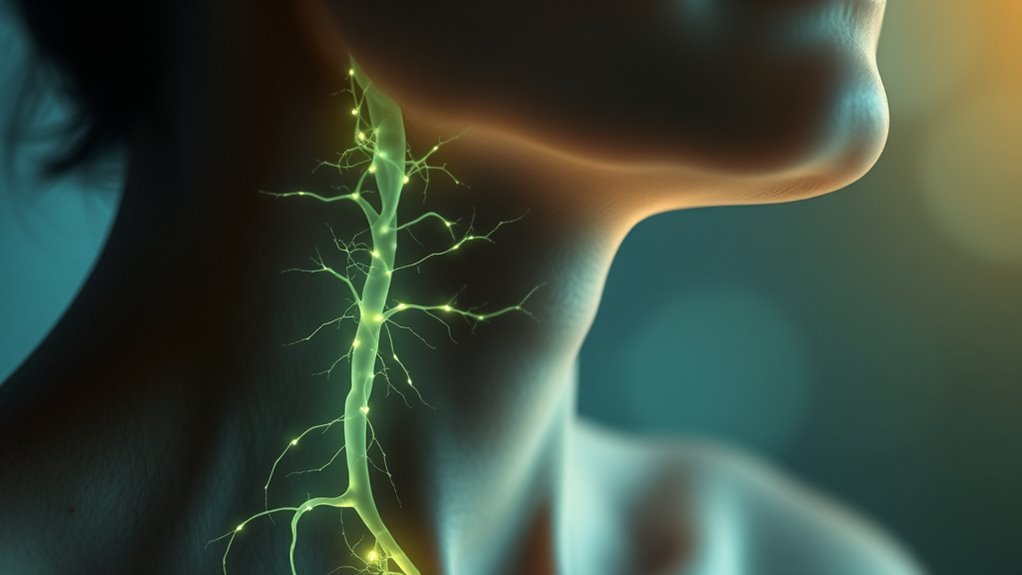
Your vagus nerve plays a key role in shaping your mood and emotional responses by maintaining your vagal tone. It helps regulate your stress reactions, keeping you calm during challenging moments. Additionally, it signals social engagement cues, influencing how you connect and communicate with others. Some research suggests that engaging with dog names can positively impact your emotional well-being, reflecting the deep bond between humans and their pets. Moreover, practices like glamping that foster relaxation and connection with nature may also enhance vagal tone, promoting overall emotional health. Incorporating mindfulness techniques such as deep breathing or visualization can further boost your vagal tone, supporting emotional stability and resilience.
Vagal Tone and Mood
Ever wonder how your emotional state can shift so quickly? It’s often linked to your vagal tone, which influences your ability to regulate mood. When your vagal tone is high, you’re more likely to stay calm and balanced. When it’s low, stress and anxiety can take over. Visualize this process:
- Your vagus nerve fires signals like gentle waves, calming your mind.
- Your heart rate slows, creating a sense of peace.
- Your breathing becomes steady, reducing tension.
- Your mood stabilizes, helping you respond thoughtfully instead of reactively.
- The vetted 1st home theatre projector can enhance your relaxation environment, supporting a calm mental state. Developing a healthy vagal tone can be influenced by practices like deep breathing, meditation, and physical activity, which are known to strengthen the vagus nerve. Engaging in activities that promote sound design techniques can also contribute to emotional regulation by creating calming auditory environments.
Stress Response Regulation
The vagus nerve plays a crucial role in regulating the body’s stress response by modulating how emotions and behaviors unfold during challenging situations. When you engage in mindfulness practices and breath techniques, you activate your vagus nerve, promoting relaxation and calming your nervous system. This helps shift you from a state of fight-or-flight to one of safety and calm. To deepen this effect, consider how your responses relate to the following:
| Response Type | Effect on Stress | Techniques to Activate Vagus Nerve |
|---|---|---|
| Sympathetic | Increased stress | Deep, slow breathing |
| Parasympathetic | Relaxation | Mindfulness and meditation |
| Emotional Regulation | Stability | Sustained breath focus |
Additionally, understanding how the mind-body connection influences your emotional responses can enhance your ability to regulate stress effectively. Recognizing the importance of vagus nerve stimulation can further improve your emotional resilience and overall well-being. Engaging in activities that support autonomic nervous system balance can optimize your stress regulation strategies.
Social Engagement Signals
Engaging the vagus nerve doesn’t just calm your body; it also influences how you connect with others through social signals. When your vagus nerve is active, you send subtle cues that promote trust and safety. These include:
- Mirroring gestures, like matching someone’s posture or facial expressions, which foster connection.
- Tone of voice, which becomes warm and soothing, encouraging open communication.
- Facial expressions that appear relaxed and inviting, signaling safety.
- Vocal pitch modulation that reflects genuine engagement, making interactions more empathetic.
- The activation of social engagement signals, which enhances interpersonal bonds and promotes positive social interactions. Studies show that these signals are also linked to energetic alignment, strengthening the emotional connection between individuals.
The Role of Safety and Threat in Emotional Responses

How do you know when to feel safe or threatened? Your body constantly assesses environmental cues to determine threat perception, influencing your emotional safety. When signals indicate safety, your vagus nerve promotes a calm state, supporting relaxation and social connection. Conversely, if danger seems imminent, your nervous system shifts into a threat response, activating fight, flight, or freeze. This shift is a survival mechanism, but it also impacts your emotional regulation. Recognizing how safety and threat influence your responses helps you understand why certain situations trigger anxiety or calmness. Your brain’s ability to interpret cues accurately is essential for managing these responses. By fostering emotional safety, you can engage your vagus nerve’s calming pathways, reducing stress and enhancing overall emotional resilience. Additionally, understanding the horsepower of electric dirt bikes can offer insight into how physical energy levels might influence your body’s capacity to respond to stress or relaxation cues. Developing cultural intelligence can further improve your ability to interpret social cues and foster emotional safety in diverse environments.
Polyvagal Theory and Social Engagement

Your social engagement system activates when you feel safe, helping you read facial expressions and regulate essential signs. This response fosters connection and trust with others. By understanding these mechanisms, you can improve your ability to build meaningful relationships and manage emotional states effectively. Additionally, engaging in activities that promote a sense of safety can strengthen your emotional regulation and social engagement skills. Recognizing how physiological responses like the vagus nerve influence emotional states can further support developing resilience and social confidence.
Social Engagement System Activation
The Social Engagement System, as explained by Polyvagal Theory, plays a crucial role in how you connect with others and regulate your emotions. When this system activates, your body becomes tuned for social interaction through auditory communication and facial feedback. You might notice:
- Your ears picking up subtle sounds, like a friend’s laughter or tone of voice
- Your facial muscles responding with smiles or nods to show understanding
- Your gaze locking onto someone’s eyes, creating a sense of connection
- Your voice modulating naturally to convey warmth and attentiveness
These responses help you feel safe and engaged, promoting social bonds. Activation of this system signals safety, encouraging open communication and emotional regulation through social cues.
Facial Expressions & Vitals
Facial expressions serve as essential indicators of your emotional state and play a key role in social engagement, especially when viewed through the lens of Polyvagal Theory. When you display open, relaxed facial expressions, it signals to others that your crucial signs—heart rate, breathing, and muscle tension—are within a calm, socially engaged state. Conversely, tense or constricted facial muscles can indicate heightened arousal or stress, reflecting changes in your vital signs. These facial cues help regulate social interactions by communicating safety or threat without words. Your vagus nerve influences both facial expressions and vital signs, shaping how you connect with others. Recognizing these signs offers insight into your emotional regulation and the social cues that promote connection or withdrawal.
Enhancing Connection Skills
Understanding and applying principles from Polyvagal Theory can considerably enhance your connection skills. When you practice mindful breathing and develop emotional awareness, you signal safety to your vagus nerve, fostering social engagement. To strengthen these skills, imagine:
- Taking slow, deep breaths, calming your nervous system before interactions.
- Noticing your emotional state and accepting it without judgment, creating openness.
- Making eye contact and gentle facial expressions that invite trust.
- Listening actively, showing genuine interest to deepen the connection.
These steps help your body shift into a social engagement state, making it easier to connect authentically. As your emotional awareness grows, your ability to foster safe, meaningful interactions naturally improves, strengthening your social bonds.
Implications for Trauma and Stress Recovery

Because the vagus nerve plays a crucial role in regulating emotional responses, it offers promising avenues for trauma and stress recovery. By enhancing vagal modulation, you can help restore balance to your nervous system, reducing hyperarousal and promoting calming states. This process strengthens your emotional resilience, making it easier to cope with stressors and traumatic memories. When your vagus nerve functions effectively, you’re better equipped to shift from a state of defense to one of safety and connection. This shift supports healing by allowing you to process emotions more adaptively and regain a sense of control. Improving vagal tone can be a essential tool in your recovery, fostering a sense of calm and stability essential for overcoming trauma and stress.
Practical Strategies for Engaging the Vagus Nerve

Engaging the vagus nerve can be achieved through simple, practical techniques that promote relaxation and emotional regulation. Vagal exercises and calming techniques are effective tools to activate your parasympathetic nervous system. To get started, try:
- Taking slow, deep breaths, focusing on extending your exhale to stimulate vagal tone.
- Gently humming or chanting to vibrate your vocal cords, which activates the vagus nerve.
- Practicing progressive muscle relaxation, tensing and relaxing muscle groups to ease tension.
- Engaging in cold exposure, like splashing cold water on your face, to trigger calming responses.
These methods help you access the calming effects of your vagus nerve, supporting emotional balance and resilience. Regular practice makes these techniques even more effective.
The Connection Between Physiology and Emotional Resilience

Your nervous system plays a vital role in how you handle stress and recover from setbacks. When it’s balanced, your body maintains a calm, resilient state that helps regulate your emotions. Understanding this connection can empower you to strengthen your emotional resilience through physiological awareness.
Nervous System’s Role
The nervous system plays a crucial role in shaping emotional resilience by regulating how you respond to stress and manage your feelings. It controls autonomic responses that influence your heart rate and overall state. When faced with a challenge, your nervous system triggers reactions such as:
- Rapid increase in heart rate, preparing you for action.
- Shifting between calm and alert states through vagal tone.
- Activation of the sympathetic nervous system during stress.
- Engagement of the parasympathetic branch to restore calm.
These responses help you adapt or become overwhelmed. Your physiology directly impacts your emotional resilience, with a well-regulated nervous system fostering stability and recovery, while dysregulation may lead to anxiety or emotional exhaustion.
Stress Response Balance
Balancing the stress response is essential for maintaining emotional resilience, as it determines how effectively your body and mind recover from challenges. When your stress response is well-regulated, you can shift into a calm state more easily. Practicing mindful breathing helps you activate your vagus nerve, promoting heart coherence—a state where your heart, breath, and mind are in sync. This synchronization reduces stress hormones and enhances emotional stability. By consciously slowing your breath and focusing on each inhale and exhale, you signal to your nervous system that it’s safe to relax. Over time, cultivating heart coherence strengthens your ability to manage stress, allowing you to respond more adaptively to life’s ups and downs. This balance supports overall emotional resilience and well-being.
Future Directions in Polyvagal Research
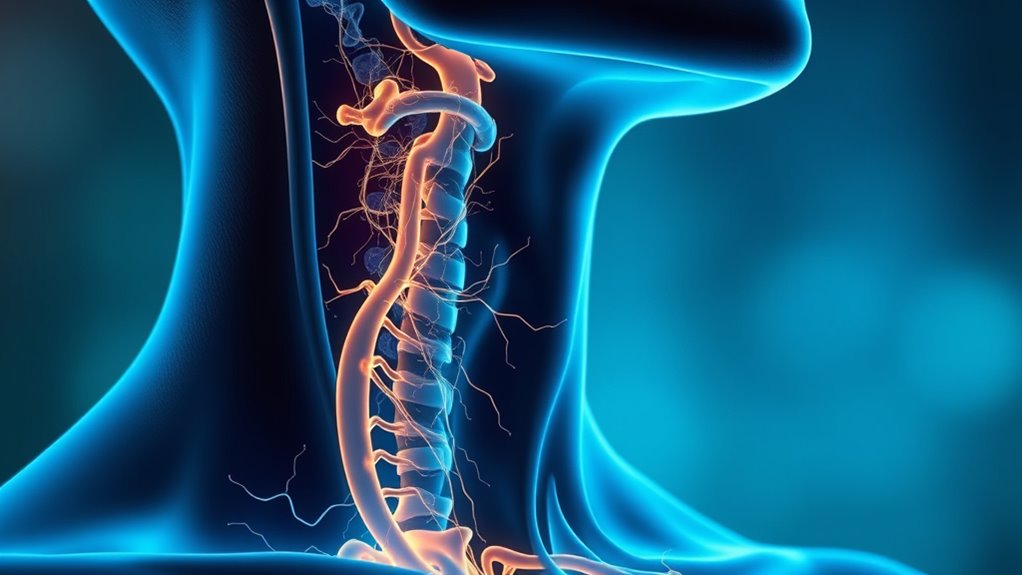
As polyvagal theory continues to gain traction, researchers are exploring innovative ways to deepen our understanding of vagal pathways and their role in emotional regulation. Future research focuses on neuroplasticity evolution, revealing how the vagus nerve adapts over time with experience and therapy. You might see advancements like:
- Developing targeted interventions to enhance vagal tone through neuroplasticity.
- Using biofeedback and wearable tech to monitor vagal responses in real-time.
- Exploring genetic factors influencing individual differences in vagal adaptability.
- Mapping neural circuits to understand how neuroplasticity evolves across life stages.
These efforts aim to liberate new pathways for emotional regulation, helping you harness your vagus nerve’s potential for resilience and well-being.
Frequently Asked Questions
Can Polyvagal Theory Be Applied to Improve Mental Health Treatments?
You can definitely apply the current question to improve mental health treatments by focusing on the mind-body connection. Understanding how your vagus nerve influences emotional regulation helps you develop techniques like breathing exercises or mindfulness to calm your nervous system. This approach enhances emotional resilience and reduces anxiety. Integrating these insights into therapy or self-care routines allows you to better manage stress and foster overall mental well-being.
How Does the Vagus Nerve Affect Autoimmune Diseases?
You might wonder how the vagus nerve influences autoimmune diseases. It plays a key role in regulating your immune response and controlling inflammation. When the vagus nerve is active, it helps reduce inflammation, which is often a major issue in autoimmune conditions. By engaging this nerve through techniques like deep breathing or biofeedback, you can potentially modulate your immune response and alleviate some symptoms related to autoimmune diseases.
Are There Specific Exercises to Strengthen the Vagus Nerve?
Think of vagus exercises as tuning a delicate instrument—you can enhance its harmony through nerve stimulation. You can try deep, slow breathing, humming, or singing to activate your vagus nerve. Cold exposure and gentle yoga also serve as effective vagus exercises. These activities help strengthen your vagus nerve, improving emotional regulation and overall well-being by sending calming signals throughout your body.
What Are the Risks of Overstimulating the Vagus Nerve?
You might wonder about vagus nerve overstimulation risks, especially since it can lead to emotional regulation challenges. While gentle stimulation often benefits your well-being, overstimulating the vagus nerve could cause dizziness, fainting, or a sudden drop in heart rate. Stay mindful of how your body responds during exercises, and avoid pushing too hard, as overstimulation might disrupt your emotional balance rather than improve it.
How Does Polyvagal Theory Relate to Developmental Childhood Disorders?
You see, understanding how childhood developmental disorders relate to trauma responses and attachment patterns can be eye-opening. Polyvagal Theory explains how the vagus nerve influences emotional regulation, shaping how children respond to stress and connect with others. When the vagus nerve isn’t functioning properly, it can lead to shy, anxious, or withdrawn behaviors, affecting attachment. Recognizing this link helps you support healthier emotional development and foster secure attachments.
Conclusion
As you gently nurture your vagus nerve, you open the door to calmer seas and brighter horizons within. By understanding its silent guidance, you can steer through storms with grace, fostering resilience and peace. Embrace simple practices to soothe your nervous system, allowing your inner garden to flourish. With patience and care, you’ll find your emotional landscape transforming into a tranquil sanctuary, where safety blooms and each moment feels like a gentle sunrise.









